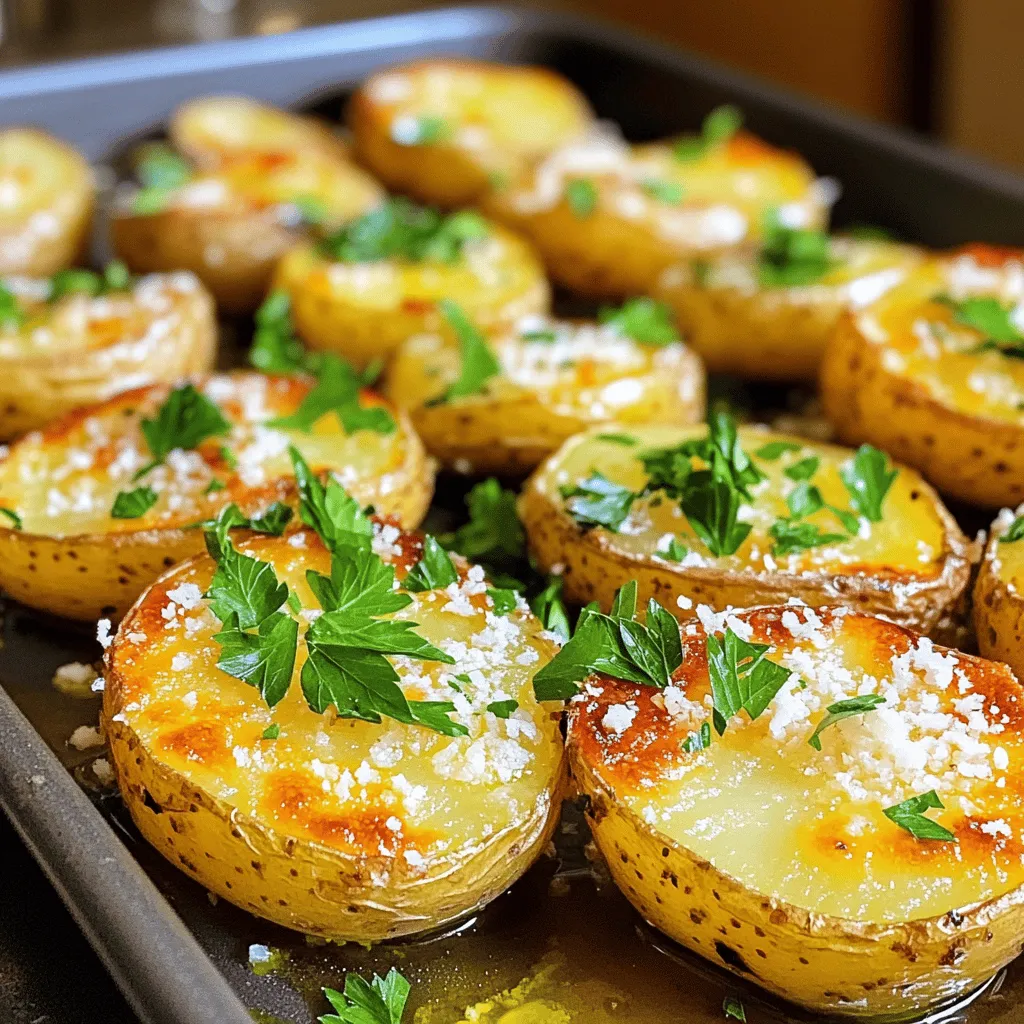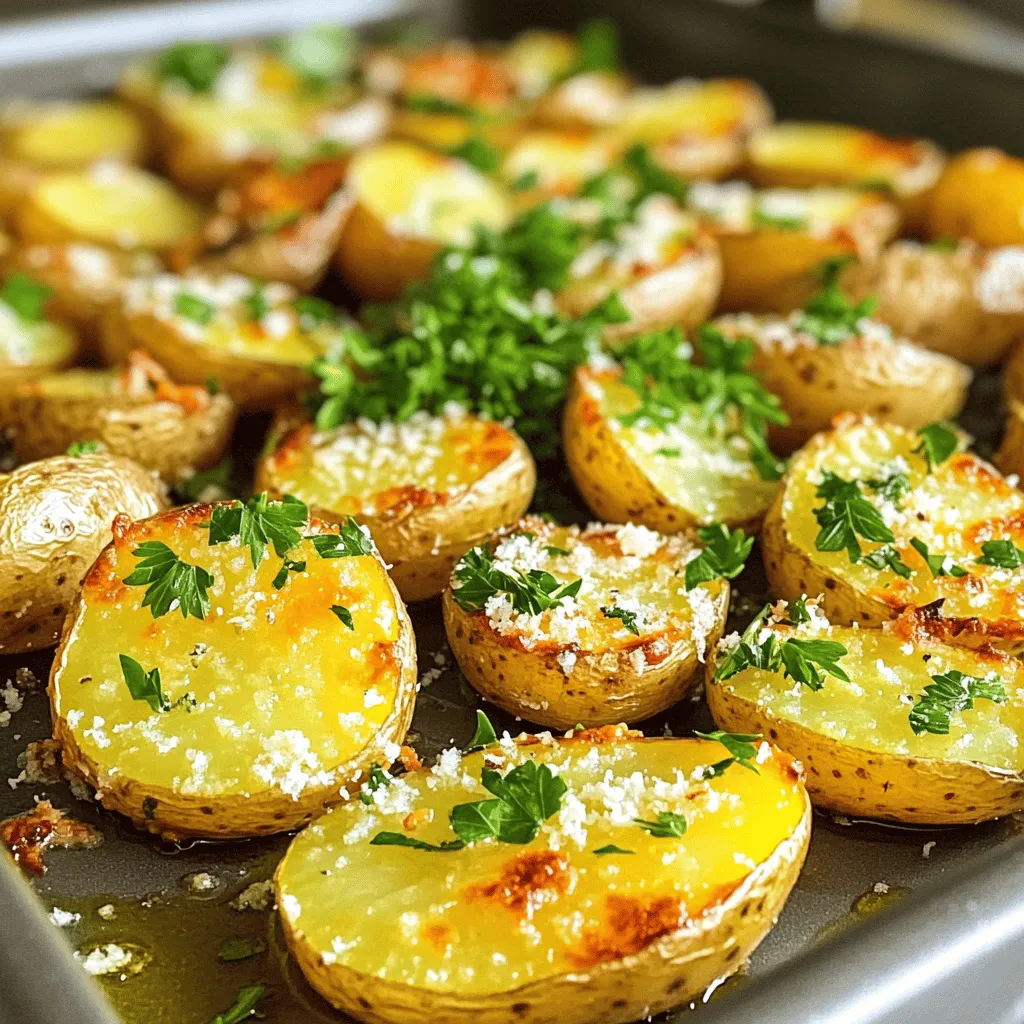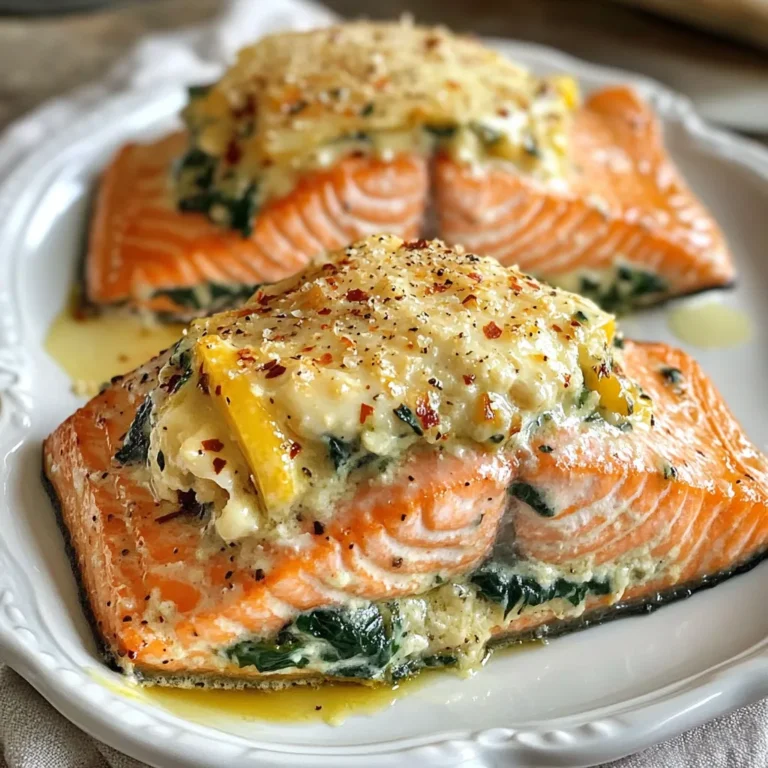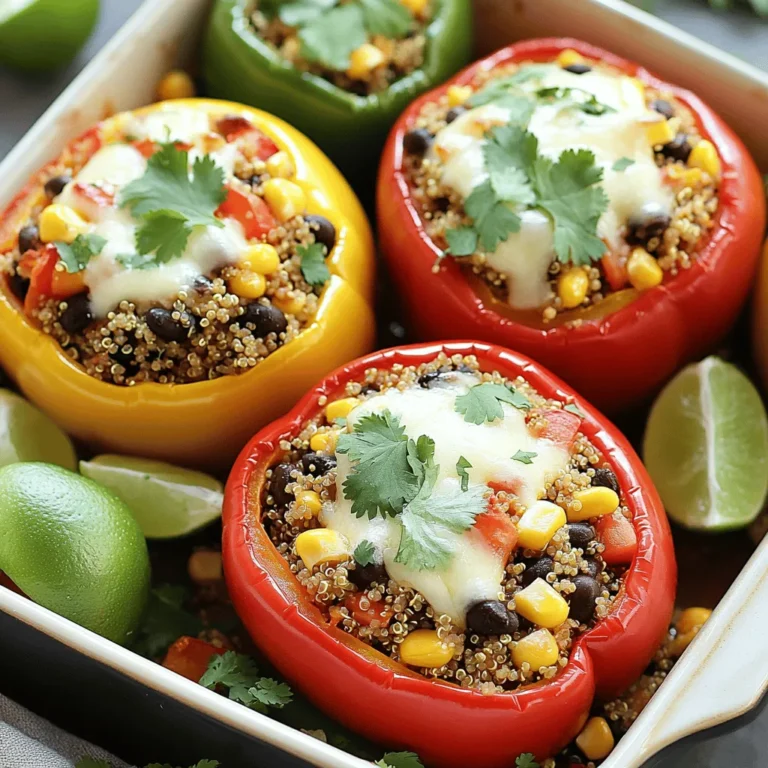Parmesan Herb Roasted Potatoes Flavorful Side Dish

Looking for a tasty side dish that packs a punch? You’ll love these Parmesan Herb Roasted Potatoes! They are easy to make and full of flavor. With a crispy exterior and soft inside, they elevate any meal. In this post, I’ll walk you through the ingredients, steps, and tips to make them perfect. Let’s dive in and get cooking!They are simple to make and fill your home with a warm, cozy aroma. This dish pairs well with almost any main meal. You can enjoy them at family dinners or casual get-togethers.
List of Ingredients
To make these roasted potatoes, here is what you need:
- 2 pounds baby potatoes, halved
- 1/2 cup freshly grated Parmesan cheese
- 3 tablespoons extra-virgin olive oil
- 2 teaspoons dried oregano
- 2 teaspoons dried thyme
- 1 teaspoon garlic powder
- Salt and freshly ground black pepper to taste
- Fresh parsley or chives, finely chopped, for garnish (optional)
Optional Ingredients for Variation
You can change this recipe to fit your taste. Here are some ideas:
- Add red pepper flakes for a bit of heat.
- Use fresh herbs instead of dried ones for a stronger flavor.
- Swap Parmesan cheese with Pecorino Romano for a sharper taste.
- Mix in lemon zest for a refreshing twist.
These optional ingredients can make your dish even more exciting!
Step-by-Step Instructions
Preparation Steps
To start, gather all your ingredients. You need 2 pounds of baby potatoes. Halve each potato to help them cook evenly. In a large mixing bowl, toss the halved potatoes with 3 tablespoons of olive oil. This oil adds flavor and helps with crisping. Next, sprinkle in 2 teaspoons of dried oregano and 2 teaspoons of dried thyme. Then add 1 teaspoon of garlic powder, salt, and pepper. Toss well to coat each potato half in the herb mix.
Cooking and Roasting Directions
Now, it’s time to roast! Preheat your oven to 425°F (220°C). This step is key for crispy potatoes. Line a baking sheet with parchment paper for easy cleanup. Spread the seasoned potatoes in a single layer. Make sure they have space between them; this helps them roast better. Place the baking sheet in the oven and roast for 25-30 minutes. Halfway through, take them out and toss the potatoes. This ensures they brown evenly. Keep an eye on them; you want them golden brown and crispy.
Final Touches Before Serving
Once the potatoes are roasted to perfection, remove them from the oven. Let them cool for a few minutes. For a fresh finish, sprinkle with finely chopped parsley or chives. This adds color and a burst of flavor. Your Parmesan herb roasted potatoes are now ready to enjoy!
Tips & Tricks
How to Achieve Crispy Potatoes
To get crispy potatoes, start with the right oven temperature. Preheat your oven to 425°F (220°C). Use baby potatoes for the best results. Halve them to allow more surface area for browning. Toss the potatoes with olive oil and seasonings. The oil helps them crisp up nicely. Spread the potatoes in a single layer on the baking sheet. Make sure they have space between them. This step is key for airflow and even cooking. Toss the potatoes halfway through roasting to ensure they brown evenly.
Flavor Enhancements
To boost the flavor of your Parmesan herb roasted potatoes, consider adding fresh herbs. Fresh rosemary or basil can add a nice twist. You can also mix in some chili flakes for a little heat. A squeeze of lemon juice right before serving brightens the dish. If you love garlic, try roasting a few whole cloves with the potatoes. It adds a sweet and rich flavor that pairs well with Parmesan.
Substitutions for Ingredients
If you run out of Parmesan cheese, try using Pecorino Romano instead. It has a similar flavor and works well. You can swap olive oil for melted butter for a richer taste. For herbs, fresh ones can take the dish to the next level. Use about three times as much fresh herbs as dried ones. If you need a dairy-free option, try nutritional yeast for a cheesy flavor. Each of these substitutions keeps the dish tasty while adding your personal touch.

Variations
Herb Variations
You can change the herbs in these potatoes. Try rosemary for a piney taste. Basil adds a sweet flavor. You can also use fresh herbs if you have them. Just chop them finely. Mix about one tablespoon of fresh herbs instead of the dried ones.
Cheese Options
Parmesan shines in this dish, but you can switch it up. Try Pecorino Romano for a sharper kick. Cheddar adds creaminess and a different taste. For a richer flavor, use Gruyère. Just make sure to grate it finely for even melting.
Alternate Cooking Methods
If you want to try a different way to cook these potatoes, consider air frying. Set your air fryer to 400°F and cook for about 20 minutes. Shake the basket halfway for even cooking. You can also boil the potatoes first. This makes them soft inside before roasting.
Storage Info
How to Store Leftovers
To store your leftover Parmesan herb roasted potatoes, let them cool first. Place them in an airtight container. They will keep well in your fridge for about three days. Make sure to keep them away from strong-smelling foods to avoid absorbing those odors.
Reheating Instructions
When you’re ready to enjoy your leftovers, preheat your oven to 400°F (200°C). Spread the potatoes on a baking sheet. Heat them for about 10-15 minutes, or until they are hot and crispy again. You can also use a microwave, but this may make them a bit soft.
Freezing Parmesan Herb Roasted Potatoes
If you want to freeze these potatoes, it’s best to do it before cooking. After mixing the potatoes and spices, place them on a baking sheet in a single layer. Freeze them for a couple of hours, then transfer them to a freezer bag. When you want to cook them, no need to thaw; just roast them straight from the freezer. Be sure to check the cooking time, as it may need a bit longer.
FAQs
How long do Parmesan Herb Roasted Potatoes last?
Parmesan Herb Roasted Potatoes last about 3 to 5 days when stored properly. Place them in an airtight container and keep them in the fridge. This way, they stay fresh and tasty for your next meal.
Can I make these potatoes ahead of time?
Yes, you can make these potatoes ahead of time. Cook them fully, then let them cool. Store the cooked potatoes in the fridge for up to 5 days. When you’re ready to serve, you can reheat them in the oven for a crispy finish.
What can I serve with Parmesan Herb Roasted Potatoes?
Parmesan Herb Roasted Potatoes go well with many dishes. They pair nicely with grilled chicken, steak, or roasted fish. You can also serve them with a fresh salad or as part of a veggie platter.
You learned about making tasty Parmesan Herb Roasted Potatoes. We covered the key ingredients, step-by-step cooking, and helpful tips. Remember, feel free to mix things up with variations or different herbs. Proper storage extends your leftovers, and reheating keeps them tasty. With these easy steps, you’ll impress family and friends. Enjoy this simple dish anytime.


![To make tasty roasted veggie grain bowls, gather these items: - 1 cup quinoa, thoroughly rinsed - 2 cups vegetable broth - 1 zucchini, diced into bite-sized pieces - 1 red bell pepper, diced - 1 cup cherry tomatoes, halved - 1 cup broccoli florets, cut into small pieces - 2 tablespoons olive oil - 1 teaspoon garlic powder - 1 teaspoon smoked paprika - Salt and freshly cracked black pepper, to taste - 1 avocado, halved and sliced - ¼ cup tahini - 2 tablespoons freshly squeezed lemon juice - Fresh herbs (such as parsley or cilantro) for garnish Fresh ingredients make a big difference. Choose bright, firm veggies for the best flavor. Here are some tips to ensure freshness: - Look for vibrant colors: Fresh veggies should be bright and appealing. - Check for firmness: Avoid soft or wrinkled produce. - Buy local when possible: Seasonal veggies taste better and last longer. You can swap some ingredients based on your taste or what you have. Here are easy swaps: - Quinoa: Use farro, rice, or barley instead. - Veggies: Try carrots, asparagus, or sweet potatoes. - Tahini: Substitute with yogurt or nut butter for a different sauce. - Herbs: Use basil, dill, or chives for fresh flavor. Explore these options to make your roasted veggie grain bowls unique! For the complete recipe, check the Full Recipe. Start by preheating your oven to 425°F (220°C). This heat is perfect for roasting. While the oven warms, prepare the quinoa. In a medium saucepan, bring 2 cups of vegetable broth to a boil. Once boiling, add 1 cup of rinsed quinoa. Lower the heat, cover, and let it simmer for about 15 minutes. The quinoa will soak up the broth and become fluffy. After cooking, let it rest for 5 minutes. Fluff it with a fork before serving. While the quinoa cooks, prepare your veggies. Grab a large baking sheet and add the diced zucchini, red bell pepper, halved cherry tomatoes, and broccoli florets. Drizzle 2 tablespoons of olive oil over these veggies. Then, sprinkle 1 teaspoon of garlic powder, 1 teaspoon of smoked paprika, salt, and freshly cracked black pepper. Mix everything well to coat the veggies. Place the baking sheet in the oven and roast for 20-25 minutes. Halfway through, stir the veggies to ensure even cooking. They are done when tender and slightly caramelized. For the tahini sauce, combine ¼ cup of tahini and 2 tablespoons of freshly squeezed lemon juice in a small bowl. Whisk them together until smooth. Add a pinch of salt for flavor. If the sauce seems too thick, thin it out with a little water. Adjust it until you reach your desired consistency. You can check the [Full Recipe] for more details. When making roasted veggie grain bowls, avoid overcooking your vegetables. They should be tender but not mushy. Also, don't skip the seasoning. A little salt and pepper make a big difference. Lastly, ensure the quinoa is fluffed well after cooking. This helps the grains mix nicely with the veggies. To boost flavor, try marinating the veggies in olive oil and spices before roasting. You can add herbs like thyme or rosemary for a fresh taste. For texture, consider adding nuts or seeds. Toasted sunflower seeds or crunchy almonds add a nice bite. Roasted veggie grain bowls are great for a filling meal. Pair them with a side salad for more greens. You can also add a protein like grilled chicken or chickpeas for extra nutrition. For a wow factor, drizzle more tahini sauce on top or sprinkle with feta cheese. Check out the Full Recipe for more ideas! {{image_4}} You can switch up the grains in your bowl. Try brown rice, farro, or barley. Each grain brings a different taste and texture. Quinoa is great, but experimenting keeps it fun. You can also use millet for a unique twist. These grains offer more fiber and nutrients. Explore different cooking times for each grain to get them just right. Seasonal veggies make your grain bowl fresh and vibrant. In spring, use asparagus and peas. Summer calls for corn and eggplant. Fall brings sweet potatoes and kale. In winter, think about Brussels sprouts and root vegetables. Each season gives you new flavors and colors. Using fresh, local produce can boost taste and nutrition. Toppings can elevate your bowl. Consider adding nuts or seeds for crunch. Roasted chickpeas add protein and flavor. You might also try feta cheese for a salty kick. Fresh herbs like basil or cilantro can brighten the dish. A squeeze of lime or lemon juice adds freshness. For a spicy touch, drizzle hot sauce or sprinkle red pepper flakes. Each addition brings a new layer of flavor to your meal. Check out the Full Recipe for more ideas! To keep your roasted veggie grain bowls fresh, store them in airtight containers. Make sure to let the bowls cool down before sealing them. This helps prevent moisture buildup, which can make your veggies soggy. You can keep them in the fridge for up to four days. When you’re ready to enjoy your leftovers, reheat them gently. Use the microwave for quick heating. Heat in short bursts, stirring in between, to avoid hot spots. You can also warm them in a pan over low heat. Add a splash of water or broth to keep them moist. Meal prepping is a great way to save time. You can make extra quinoa and roast a variety of veggies. Store them separately in the fridge for easy access. This way, you can mix and match different flavors throughout the week. Just assemble the bowls when you're ready to eat. For a detailed recipe, check the Full Recipe for all the steps! Roasted veggie grain bowls are healthy meals filled with grains and vegetables. They combine cooked grains, like quinoa, with roasted veggies. This mix creates a tasty and colorful dish. You get fiber, vitamins, and minerals in every bite. The flavors blend well, making each bowl satisfying and fun to eat. To make roasted veggie grain bowls, follow these steps: 1. Preheat your oven to 425°F (220°C). 2. Cook 1 cup of quinoa in 2 cups of vegetable broth. Let it simmer until fluffy. 3. Prepare your veggies: dice zucchini, red bell pepper, and halve cherry tomatoes. Add broccoli florets. 4. Toss the veggies with olive oil, garlic powder, smoked paprika, salt, and pepper. 5. Roast the veggies for 20-25 minutes until tender and slightly caramelized. 6. Mix tahini with lemon juice, adding water if needed for the right texture. 7. Assemble the bowls with quinoa, roasted veggies, and avocado slices on top. 8. Drizzle with tahini sauce and add fresh herbs for garnish. You can find the full recipe above for more detailed steps. Yes, you can customize this recipe. Use different grains like brown rice or farro. Change the veggies based on what you like or what is in season. You can also add proteins like chickpeas or grilled chicken. Experiment with different sauces or toppings to make the dish your own. This flexibility makes roasted veggie grain bowls perfect for everyone. This blog covered how to make delicious roasted veggie grain bowls. We discussed key ingredients, focusing on freshness and substitutions. I shared step-by-step instructions for prepping, roasting, and creating a tasty tahini sauce. You learned helpful tips to avoid mistakes and enhance flavor. Variations allowed you to experiment with grains and veggies. Lastly, I provided storage tips to keep leftovers fresh. Roasted veggie grain bowls are flexible and fun. You can mix and match to fit your taste. Enjoy experimenting!](https://dishtreats.com/wp-content/uploads/2025/07/945baa8c-ba42-4ceb-8d11-39d9a326283a-768x768.webp)


![To make Honey Mustard Chicken Thighs, you need simple, fresh ingredients. Here’s what you will need: - 4 bone-in chicken thighs, skin-on - 1/4 cup honey - 1/4 cup Dijon mustard - 2 tablespoons olive oil - 3 cloves garlic, minced - 1 teaspoon dried thyme - 1 teaspoon paprika - Salt and black pepper to taste - Fresh parsley for garnish These ingredients bring great flavor to your meal. The honey adds sweetness, while the Dijon mustard gives it a nice tang. Olive oil keeps the chicken juicy, and garlic boosts the taste. Dried thyme and paprika add depth, making every bite delicious. Don’t forget the parsley! It makes your dish look pretty and fresh. This recipe is quick and easy, perfect for any night. For the full instructions, check the Full Recipe. First, preheat your oven to 400°F (200°C). This heat will cook your chicken just right. In a small bowl, whisk together these ingredients: - 1/4 cup honey - 1/4 cup Dijon mustard - 2 tablespoons olive oil - 3 cloves garlic, minced - 1 teaspoon dried thyme - 1 teaspoon paprika - Salt and black pepper to taste Make sure to mix well. This creates a smooth and tasty marinade. Next, take your chicken thighs and place them in a large bowl or a resealable bag. Pour the marinade over the chicken. Ensure each piece is coated well. For the best flavor, let it marinate for at least 30 minutes. If you have more time, refrigerating it overnight works wonders. Now, heat a large oven-safe skillet over medium-high heat. Once hot, add the marinated chicken thighs, skin-side down. Sear them for about 5-7 minutes until the skin is golden brown. This step gives the chicken a nice crisp. After that, flip the thighs using tongs. Transfer the skillet to your preheated oven. Bake for 25-30 minutes. Check that the internal temperature reaches 165°F (75°C). If the juices run clear, the chicken is done. Once cooked, take the skillet from the oven and let the chicken rest for 5 minutes. This helps keep it juicy. Before serving, sprinkle some fresh parsley on top for a lovely finish. For the complete recipe, don't forget to check the [Full Recipe]. To get the best flavor, marinate the chicken thighs well. Use a large bowl or a resealable plastic bag for this. After mixing the marinade, pour it over the chicken. Make sure each piece is coated. For great results, let the chicken sit in the marinade for at least 30 minutes. You can also refrigerate it overnight. This extra time helps the flavors soak in deep. Cooking chicken thighs at the right temperature is key. Preheat your oven to 400°F (200°C). This hot oven cooks the chicken evenly and keeps it juicy. After searing the chicken for 5-7 minutes on the stovetop, transfer it to the oven. Bake for 25-30 minutes. Check the chicken's internal temperature. It should reach 165°F (75°C) for safe eating. Let it rest for 5 minutes before serving, which helps keep it moist. When serving, presentation matters. Place the chicken thighs on a white platter or a wooden board. Drizzle any leftover marinade over the top for added flavor. Garnish with fresh parsley for a pop of color. This simple touch makes the dish look more inviting. You can pair the chicken with roasted veggies or a fresh salad. These sides complement the sweet and tangy flavors of the honey mustard. For the full recipe, check out the details above. {{image_4}} You can change the sauce to fit your taste. Try using maple syrup instead of honey. This gives a unique sweetness. You can also mix in some soy sauce for a savory twist. If you like heat, add a dash of hot sauce or cayenne pepper. For a tangy flavor, consider apple cider vinegar. Each option adds a new layer to the dish. While chicken thighs are great, you can also use chicken breasts. They cook faster but stay moist if cooked right. Drumsticks are another option. They have lots of flavor and a nice crisp skin. You can even use a whole chicken, just adjust cooking time. Each cut brings its own charm to the recipe. For a full meal, add vegetables. Root veggies like carrots and potatoes roast well. Toss them in the marinade for extra flavor. You can also use green beans or broccoli. Place them in the skillet with the chicken. They will soak up the sauce and cook perfectly. This way, you have a tasty one-pan meal that's easy to serve. For the full recipe, check out the previous section. After cooking, let the chicken cool down. Place the chicken thighs in an airtight container. Store them in the fridge for up to three days. Make sure the temperature stays below 40°F (4°C). This keeps your chicken safe and tasty. If you want to store the chicken longer, freezing is a great option. Wrap each thigh tightly in plastic wrap. Then put them in a freezer-safe bag. You can freeze them for up to three months. Remember to label the bag with the date. When you are ready to enjoy leftovers, preheat your oven to 350°F (175°C). Place the chicken in a baking dish. Cover it with foil to keep it moist. Heat for about 20-25 minutes. You can also use a microwave, but it may dry the chicken out. For the best taste, the oven is the way to go. Enjoy your meal again! You should marinate honey mustard chicken thighs for at least 30 minutes. This allows the flavors to soak into the meat. If you have time, marinating overnight works even better. It deepens the taste and makes the chicken more tender. Yes, you can use boneless chicken thighs. They cook faster than bone-in thighs. Adjust the cooking time to about 20-25 minutes in the oven. Always check that the internal temperature reaches 165°F (75°C) for safety. Honey mustard chicken thighs pair well with many sides. Here are some ideas: - Steamed vegetables: Broccoli or green beans add color. - Rice or quinoa: Both soak up the sauce nicely. - Salad: A fresh green salad balances the meal. - Mashed potatoes: Creamy potatoes are a great comfort food option. You can find the full recipe to help you create this delicious meal. In this post, I shared ingredients and steps for making honey mustard chicken thighs. I provided tips for marinating and cooking this dish to enhance its flavor. You learned about variations and how to store leftovers properly. Remember, simple changes can make a big impact on taste. I encourage you to try these ideas for yourself. Enjoy cooking and delight in every bite!](https://dishtreats.com/wp-content/uploads/2025/06/0b4fb8df-5400-4b6b-9acb-490ad2d6fca7-768x768.webp)

